Pregnant and sushi
-
Sushi is often not recommended for pregnant women. This is a shame because sushi can be very healthy for the pregnant woman and the unborn baby. It is also only a few types of sushi that can pose a danger. For example, sushi with fresh raw salmon or raw halibut pose no danger. The dangers are often caused by the Listeria bacteria or by dioxins and PCBs.
Sushi during pregnancy
-
The main ingredient of sushi is rice. All other ingredients can vary. So there are many types of sushi, but often the traditional sushi consists of rice, nori based on seaweed and raw fish. Seaweed is rich in iodine, iron, lime, vitamins and minerals. Seaweed also contains a lot of folic acid, which contributes to the construction of the nervous system and reduces the risk of birth defects such as an open spine, cleft lip and open palate. Seaweed lowers blood pressure, which is a bonus for a pregnant woman. It also promotes healthy digestion. In addition to seaweed, the fish is also very healthy. Fish supplies include vitamin B12 and the minerals iodine, phosphorus and selenium. It is a source of Vitamin B6. The fatty fish, which is often used in sushi, is rich in vitamins D and B2 and contains vitamin A. Vitamin D is good for the bone building of the child. Eating fatty fish is especially important because of the fish fatty acids. These help keep heart and blood vessels healthy. The omega-3 fatty acids also contribute to the nervous system of the child. Sushi is therefore very healthy for pregnant women. However, it is often discouraged because it could be dangerous for the unborn baby.
Raw fish
-
In sushi fish is often used raw. Fish species that are often used in sushi are salmon and tuna, but you also sometimes see other fish such as halibut, swordfish and trout. For the taste of the sushi it is important that the fish is very fresh. If the fish smells fishy or if the color is not right, the fish is not fresh. Fish that is not fresh does not taste good and can contain dangerous bacteria.
-
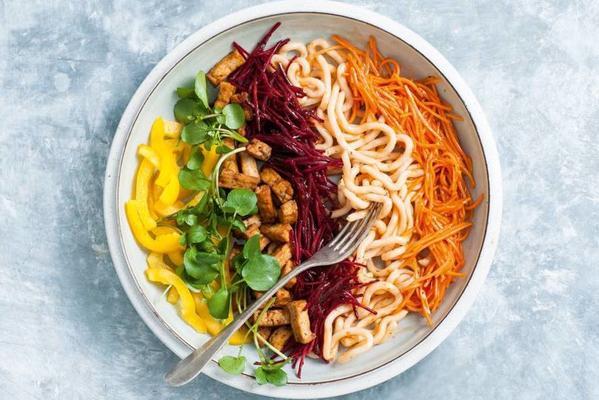 11 minMain dishpeanut oil, tofu stir-fry cubes finely seasoned, stir fry sauce sweet and sour, thick noodles, carrot julienne, beetroot julienne, yellow bell pepper, watercress,rainbow salad with tofu
11 minMain dishpeanut oil, tofu stir-fry cubes finely seasoned, stir fry sauce sweet and sour, thick noodles, carrot julienne, beetroot julienne, yellow bell pepper, watercress,rainbow salad with tofu -
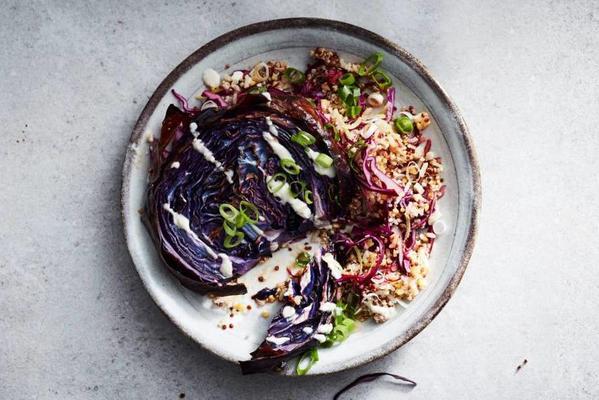 45 minMain dishRed cabbage, mild olive oil, quinoa plus, forest outing, lemon, sesame oil, soy sauce less salt, Bio Today tahini white in pot, tap water,grilled red cabbage with quinoa salad
45 minMain dishRed cabbage, mild olive oil, quinoa plus, forest outing, lemon, sesame oil, soy sauce less salt, Bio Today tahini white in pot, tap water,grilled red cabbage with quinoa salad -
 30 minDessertBrie, Roquefort, port salut, gruyere, Camembert, walnut, garlic, thyme, honey, grape, baguette, Red onion, red grape, raisins, Red wine, Red wine vinegar, Brown sugar,generous cheese plate with onion marmalade
30 minDessertBrie, Roquefort, port salut, gruyere, Camembert, walnut, garlic, thyme, honey, grape, baguette, Red onion, red grape, raisins, Red wine, Red wine vinegar, Brown sugar,generous cheese plate with onion marmalade -
 30 minDessertFull Milk, whipped cream, macaroon, custard powder, vanilla sugar, sugar, protein, amaretto, almond liqueur, basic recipe cooking pears,macaroon pastry with casserole
30 minDessertFull Milk, whipped cream, macaroon, custard powder, vanilla sugar, sugar, protein, amaretto, almond liqueur, basic recipe cooking pears,macaroon pastry with casserole
Bacteria in fish
-
Raw fish can grow a number of pathogenic bacteria such as Salmonella and Listeria. Listeria can be partially controlled by stomach acid and must be present in sufficient numbers to make a healthy person ill. Especially in prepackaged smoked fish, Listeria can pose a great danger because it can also grow at refrigerator temperatures. Prepackaged smoked fish usually has a shelf life of 3 to 6 weeks when kept in the refrigerator. This gives the Listeria enough time to multiply to harmful amounts. The danger of Listeria for pregnant women is that it can reach the child through the placenta and lead to abortion or stillbirth. In addition, pregnant women are a risk group, because they usually have a poorer immune system and can therefore get Listeriosis more quickly than healthy adults.
Parasites in raw fish
-
Raw fish can contain dangerous parasites, the most common being the herring worm Anisakis. This parasite is called herring worm because it has been a problem in mate herring in the past. However, the parasite can also be found in other fish such as cod, haddock and wild salmon. The parasite does not occur in farmed salmon. The herring worm is killed by freezing the fish for 24 hours at a temperature of -20 ° C. This is therefore mandatory for all types of fish sold raw or cold smoked.
Viruses in raw fish
-
Raw fish and raw shellfish and crustaceans can be infected with viruses such as hepatitis A and B, rotavirus and Norwalk virus.
-
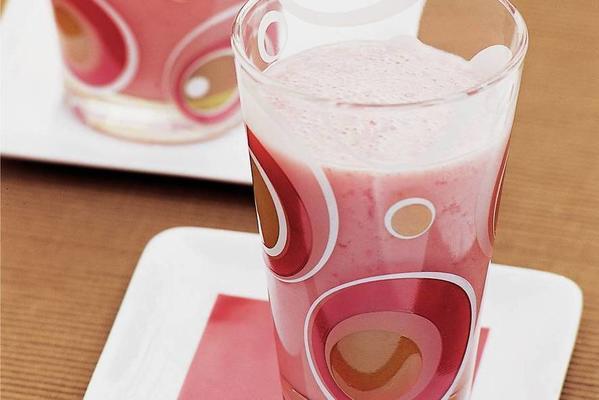 5 minDrink without alcoholbananas, cool fresh apple-pear raspberry juice, Soy drink vanilla,soy fruit shake
5 minDrink without alcoholbananas, cool fresh apple-pear raspberry juice, Soy drink vanilla,soy fruit shake -
 20 minMain dishsauerkraut, sticking potato, liquid baking product, half-to-half minced, Spice meatballs, pineapple, olive oil, liquid baking product,gratin sauerkraut dish with minced meat
20 minMain dishsauerkraut, sticking potato, liquid baking product, half-to-half minced, Spice meatballs, pineapple, olive oil, liquid baking product,gratin sauerkraut dish with minced meat -
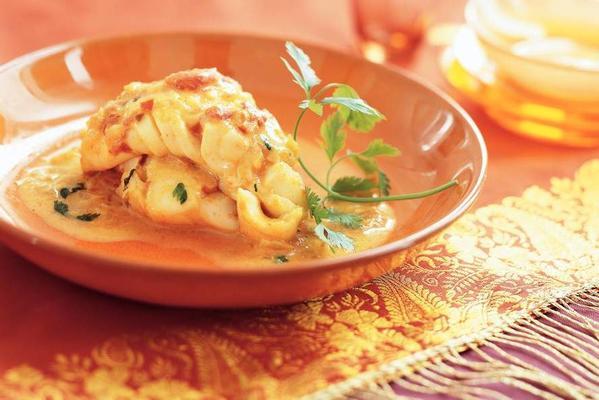 40 minMain dishlemongrass, fresh ginger, Red peppers, onions, tomato cubes, fresh cod fillet, coriander, oil, ground turmeric (koenjit), coconut milk, salt,fish in creamy coconut sauce
40 minMain dishlemongrass, fresh ginger, Red peppers, onions, tomato cubes, fresh cod fillet, coriander, oil, ground turmeric (koenjit), coconut milk, salt,fish in creamy coconut sauce -
 15 minSide dishsweet potato, soft goat cheese, egg, spring / forest onion,stuffed sweet potato with egg
15 minSide dishsweet potato, soft goat cheese, egg, spring / forest onion,stuffed sweet potato with egg
Contamination in raw fish
-
Agricultural poisons and industrial wastes end up in rivers and oceans. They absorb microorganisms, which in turn are eaten by plankton eaters. Predatory fish eat the plankton-eating animals and the pollution is stored in the fat of the predatory fish. The bigger the fish, the more pollution here. Large predatory fish such as shark, swordfish and king mackerel are therefore the most polluted. In addition, fatty fish is also more polluted than lean fish, because the pollution is stored in the fat of the fish. This mainly concerns toxic substances such as dioxins, PCBs and pesticides. Dioxins are substances that have carcinogenic properties in large quantities. They attach themselves to clay in the rivers. In the Netherlands, wild eel and mitten crab in particular are often contaminated with high levels of dioxins. Long-term exposure to a small amount of dioxins or DL-PCBs can affect fertility. In pregnant women, a lower birth weight of babies is a possible consequence. Large amounts of dioxins or DL-PCBs can damage the liver and cause skin disorders.
Which sushi is safe during pregnancy
-
Sushi made with cooked or well-washed vegetables is almost always safe to eat. Sushi made with omelets or well-cooked meat is also safe. With the more traditional species with fish, the safety depends on the risk of pollution and contamination with Listeria. An overview of safe and less safe fish species is given below.
Fish species that may contain high levels of dioxin:
-
 20 minMain dishTasty vine tomato, (olive oil, fresh basil, onion, garlic, Parmigiano Reggiano, zucchini spaghetti, pumpkin spaghetti, mini buffalo mozzarella,lukewarm pumpkin and zucchini spaghetti
20 minMain dishTasty vine tomato, (olive oil, fresh basil, onion, garlic, Parmigiano Reggiano, zucchini spaghetti, pumpkin spaghetti, mini buffalo mozzarella,lukewarm pumpkin and zucchini spaghetti -
 15 minSide dishtraditional olive oil, curry powder, wheat flour, coconut milk, sambal oelek, chicken broth tablet, water, fresh mango,curry sauce with mango
15 minSide dishtraditional olive oil, curry powder, wheat flour, coconut milk, sambal oelek, chicken broth tablet, water, fresh mango,curry sauce with mango -
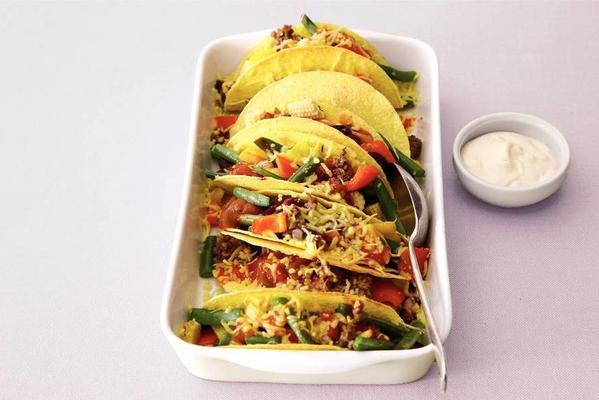 30 minMain dishtraditional olive oil, lean ground beef, frozen Mexican wok vegetables, salsa sauce mild, taco shell, grated young cheese, creme fraiche,Mexican vegetable in tacos
30 minMain dishtraditional olive oil, lean ground beef, frozen Mexican wok vegetables, salsa sauce mild, taco shell, grated young cheese, creme fraiche,Mexican vegetable in tacos -
 95 minMain dishmaize chicken, lemon, coarse sea salt, pepper, extra virgin olive oil, garlic, thyme, zucchini, tomatoes (small to), black olives without pit,provençal chicken with zucchini and tomatoes
95 minMain dishmaize chicken, lemon, coarse sea salt, pepper, extra virgin olive oil, garlic, thyme, zucchini, tomatoes (small to), black olives without pit,provençal chicken with zucchini and tomatoes
Products that may contain harmful amounts of Listeria:
-
Pre-packed processed raw fish like:
Products that are very unlikely to contain a harmful amount of Listeria:
-
Fish that is well heated just before consumption such as